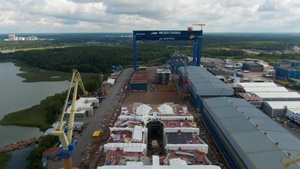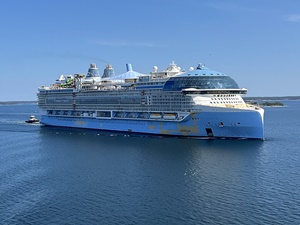World's largest cruise ship, Icon of the Seas, scheduled to set sail
- By Aniket Gupta: Following the COVID pandemic, luxury liners went temporarily taken out of service. Now they are back. With a bang. Or should we say, with a big splash? Cruise bookings have surged, and a Finnish shipyard is now in the final stages of completing what is set to become the largest cruise ship in the world.
- The luxurious ship from Royal Caribbean, named Icon of the Seas, is approaching its final stages of construction at the Meyer Turku shipyard in Turku on the south-western coast of Finland. The shipbuilding company is fully owned by German shipbuilder Meyer Werft GmbH.
- The Icon of the Seas is expected to be delivered in late 2023, and its inaugural journey is scheduled for January 2024.
- Tim Meyer, CEO of Meyer Turku, says the ship is the largest cruise ship in the world. The massive ship features lively waterparks, over 20 decks, and the capacity to accommodate nearly 10,000 people.

- Many have been attracted by the clever design and careful planning that promise an extraordinary cruise, and have eagerly purchased tickets. Others have referred to the massive construction as a ‘monstrosity’, given what they say will be its significant negative environmental impact.
- The shipping industry was severely impacted by the pandemic, casting doubt on its potential for recovery. According to the Cruise Lines International Association, passenger volume is anticipated to exceed pre-pandemic levels, projecting a total of 31.5 million passengers for the year 2023.
- Weighing a gross tonnage of 250,800, which is five times larger than the ill-fated Titanic, the Icon of the Seas is poised to claim the distinction of being the world's largest cruise ship, surpassing Royal Caribbean’s existing flagship, the Wonder of the Seas.
- Although the trend towards constructing massive ships is not expected to stop, it is likely to slow down. For financial reasons rather than engineering limitations.
- Mega-sized ships are said help lower per-passenger costs. But they require huge investments, and involve advanced technologies, which come at a significant price. Larger vessels also bring challenges like port congestion.
- Furthermore, as cruise companies aim to increase passenger capacity, they simultaneously lower the crew-to-passenger ratio, which can present difficulties in unforeseen circumstances.
- A single large ship yields greater energy efficiency compared to multiple smaller ships. Also, modern vessels have begun using liquefied natural gas (LNG), as the Icon of the Seas is doing.
- But environmentalists remain skeptical. LNG does exhibit lower emissions compared to conventional maritime fuels, yet concerns have been raised by organizations like Transport & Environment (T&E) regarding the possibility of methane leaks.
- Methane is an essential constituent of LNG. It is also a potent greenhouse gas that has the potential to inflict more severe climate repercussions than carbon dioxide.
- The T&E website says that while cruise ships account for a small proportion of the global shipping fleet, ‘they have a disproportionate impact on air quality, habitats and the climate’. Why? It’s because cruise ships require more fuel as a result of the energy demand of their onboard hotels and leisure facilities.
- These ships travel close to the coastline; so huge volumes of fuel are burned in close proximity to coastal populations. The T&E website says, ‘The technology is available to clean up cruise ships, but an industry that provides luxury trips is unwilling to deploy it.’ Source: https://www.domain-b.com/


